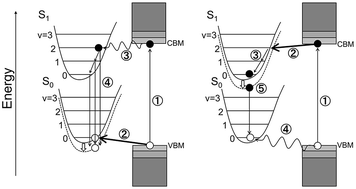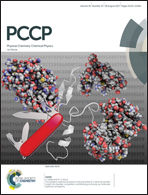Photoluminescence from vibrational excited-states for organic molecules adsorbed on Si nanoparticles
Abstract
Herein, Si nanoparticles have been fabricated from Si swarf using a bead milling method. The adsorption of 9,10-dimethylanthracene (DMA) on Si nanoparticles enhances the photoluminescence (PL) intensity by ∼60 000 times that of DMA in hexane. The PL spectra possess peaked structures due to the vibronic transition of DMA. For the excitation energies higher than 4.0 eV, vibronic bands with energies higher than the (0, 0) band were observed and attributed to PL from the vibrational excited-states. The excitation spectra showed that incident light was absorbed by both DMA and the Si nanoparticles. The lifetime of the photo-generated electron–hole pairs in the Si nanoparticles was much longer than the DMA PL lifetime; this indicated that either a hole or an electron transferred to DMA first, followed by an opposite charge transfer. In the cases where a hole is first transferred to DMA, an electronic ground-state is stabilized via solvation. When an electron is captured by the potential of the electronic excited-state, transitions from the vibrational excited-states proceed due to the high transition probability, generating PL bands with energies higher than the (0, 0) band. In the cases where an electron is first transferred to DMA, internal relaxation to the vibrational ground-state occurs, and the potential of the electronic excited-state is lowered via solvation.



 Please wait while we load your content...
Please wait while we load your content...